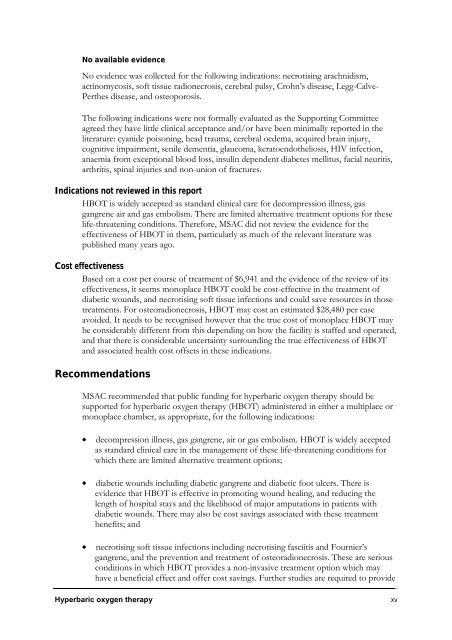Hyperbaric Oxygen Therapy - Hyperbaric Chamber Information ...
Hyperbaric Oxygen Therapy - Hyperbaric Chamber Information ...
Hyperbaric Oxygen Therapy - Hyperbaric Chamber Information ...
You also want an ePaper? Increase the reach of your titles
YUMPU automatically turns print PDFs into web optimized ePapers that Google loves.
No available evidence<br />
No evidence was collected for the following indications: necrotising arachnidism,<br />
actinomycosis, soft tissue radionecrosis, cerebral palsy, Crohn’s disease, Legg-Calve-<br />
Perthes disease, and osteoporosis.<br />
The following indications were not formally evaluated as the Supporting Committee<br />
agreed they have little clinical acceptance and/or have been minimally reported in the<br />
literature: cyanide poisoning, head trauma, cerebral oedema, acquired brain injury,<br />
cognitive impairment, senile dementia, glaucoma, keratoendotheliosis, HIV infection,<br />
anaemia from exceptional blood loss, insulin dependent diabetes mellitus, facial neuritis,<br />
arthritis, spinal injuries and non-union of fractures.<br />
Indications not reviewed in this report<br />
HBOT is widely accepted as standard clinical care for decompression illness, gas<br />
gangrene air and gas embolism. There are limited alternative treatment options for these<br />
life-threatening conditions. Therefore, MSAC did not review the evidence for the<br />
effectiveness of HBOT in them, particularly as much of the relevant literature was<br />
published many years ago.<br />
Cost effectiveness<br />
Based on a cost per course of treatment of $6,941 and the evidence of the review of its<br />
effectiveness, it seems monoplace HBOT could be cost-effective in the treatment of<br />
diabetic wounds, and necrotising soft tissue infections and could save resources in those<br />
treatments. For osteoradionecrosis, HBOT may cost an estimated $28,480 per case<br />
avoided. It needs to be recognised however that the true cost of monoplace HBOT may<br />
be considerably different from this depending on how the facility is staffed and operated,<br />
and that there is considerable uncertainty surrounding the true effectiveness of HBOT<br />
and associated health cost offsets in these indications.<br />
Recommendations<br />
MSAC recommended that public funding for hyperbaric oxygen therapy should be<br />
supported for hyperbaric oxygen therapy (HBOT) administered in either a multiplace or<br />
monoplace chamber, as appropriate, for the following indications:<br />
• decompression illness, gas gangrene, air or gas embolism. HBOT is widely accepted<br />
as standard clinical care in the management of these life-threatening conditions for<br />
which there are limited alternative treatment options;<br />
• diabetic wounds including diabetic gangrene and diabetic foot ulcers. There is<br />
evidence that HBOT is effective in promoting wound healing, and reducing the<br />
length of hospital stays and the likelihood of major amputations in patients with<br />
diabetic wounds. There may also be cost savings associated with these treatment<br />
benefits; and<br />
• necrotising soft tissue infections including necrotising fasciitis and Fournier’s<br />
gangrene, and the prevention and treatment of osteoradionecrosis. These are serious<br />
conditions in which HBOT provides a non-invasive treatment option which may<br />
have a beneficial effect and offer cost savings. Further studies are required to provide<br />
<strong>Hyperbaric</strong> oxygen therapy xv



